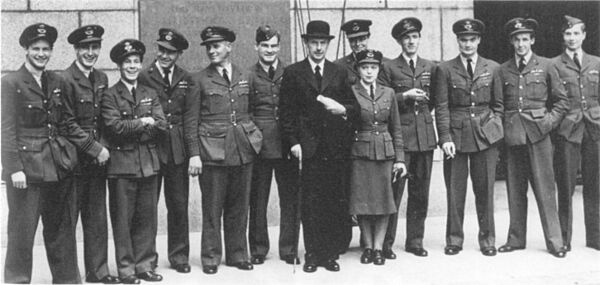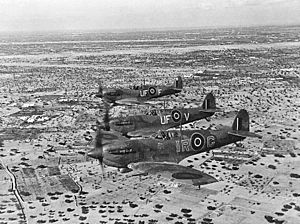Ian Gleed facts for kids
Quick facts for kids
Ian Gleed
|
|
|---|---|

Wing Commander Gleed in his Supermarine Spitfire Mk VB at an airfield in Tunisia, April 1943, days before he was shot down and killed.
|
|
| Nickname(s) | Widge |
| Born | 3 July 1916 Finchley, London |
| Died | 16 April 1943 (aged 26) Cap Bon, French Tunisia |
| Buried |
Enfidaville, Tunisia
|
| Allegiance | United Kingdom |
| Service/ |
Royal Air Force |
| Years of service | 1936–1943 |
| Rank | Wing Commander |
| Service number | 37800 |
| Unit | 87 Squadron (1940) 266 Squadron (1939–1940) 46 Squadron (1936–1939) |
| Commands held | 244 Wing (1943) Ibsley Wing (1941–1942) 87 Squadron (1940–1941) |
| Battles/wars | Second World War |
| Awards | Distinguished Service Order Distinguished Flying Cross Croix de Guerre (France) Croix de Guerre (Belgium) |
Wing Commander Ian Richard Gleed (born July 3, 1916 – died April 16, 1943), known as "Widge," was a brave Royal Air Force (RAF) pilot. He was a flying ace, meaning he shot down many enemy aircraft. During the Second World War, he destroyed 13 enemy planes.
Ian Gleed fought in important battles like the Battle of France and the Battle of Britain. Sadly, he was shot down and died over Tunisia. In 1942, he wrote a book about his experiences called Arise to Conquer. A street in Bushey, Gleed Avenue, is named after him.
Contents
Early Life and Interests
Ian Gleed was born in Finchley, a part of north London, on July 3, 1916. His father, Seymour Richard Gleed, was a doctor. He had served as a captain in the army during the First World War. Ian's sister, Daphne, also worked in medicine.
Ian went to Epsom College. He loved sailing and spent a lot of time on the water. He often told his friends that after the war, he wanted to buy a sailboat. His dream was to sail all the way to the South Seas.
Military Career Highlights
Starting as a Pilot
Ian Gleed learned to fly before joining the military. In 1936, he officially joined the RAF. He finished his flight training on Christmas Day, 1936. After training, he joined 46 Squadron. Here, he flew a biplane fighter called the Gloster Gauntlet II.
On October 9, 1938, he was promoted to flying officer. His RAF nickname, "Widge," came from his short height. People also called him "Wizard Midget" because he often used the word "wizard."
The Phoney War Period
When World War II began in September 1939, Ian Gleed moved to 266 Squadron. He became a flight commander there. In January, his squadron received new Spitfires.
In February 1940, a Spitfire he was flying broke apart in the air. Gleed was hurt when he fell out of the plane. Luckily, he woke up quickly enough to open his parachute.
Fighting in France
Gleed was able to fly again by May 14, 1940. He joined 87 Squadron, which flew Hurricane planes. This squadron was in France and had lost many pilots during the first week of the Battle of France.
Gleed got his first victories on May 18. He shot down two Bf 110 planes. The next day, he shot down one Bf 109 and probably another. He also destroyed two Do 17 bombers and shared in destroying a He 111 bomber. This meant he became a "flying ace" in just two days. This was very fast for an RAF pilot. On May 22, 87 Squadron returned to Britain.
Defending Britain
During the Battle of Britain, 87 Squadron was based at places like Church Fenton and Exeter. They flew Hurricanes. At one point, they thought about switching to Spitfires. But Gleed and another pilot, Beamont, showed that their Hurricanes could easily beat a Spitfire in a dogfight. So, they kept their Hurricanes.
During the air raids on British cities, 87 Squadron also flew at night. They defended Bristol from enemy bombers. Even though it was hard to see at night, Gleed managed to shoot down two enemy planes. In December 1940, Gleed was promoted to squadron leader. He took command of 87 Squadron at RAF Charmy Down.

A year later, in November 1941, Gleed was promoted again. At 25 years old, he became a wing commander. He was made a wing leader at RAF Middle Wallop and later at RAF Ibsley. A wing leader is in charge of flying missions for several squadrons. At Ibsley, he led 118, 234, and 501 Squadrons. They flew missions over the English Channel and protected bombers.
Gleed told his pilots to stay with the bombers they were protecting. He didn't want them to chase after enemy fighters and leave the bombers unprotected. But he was always ready to act if a good chance came up. In June 1942, he took a break from flying missions. He then worked at RAF Bentley Priory, helping with tactics and operations.
The Tunisian Campaign
Ian Gleed didn't like working at a desk. He wanted to be back in action. So, he arranged to be sent to the Middle East. This area was very active after the Torch landings. In January 1943, he took command of 244 Wing.
He got his last aerial victory on March 17. Even when newer, faster Spitfire IX planes became available, Gleed let less experienced pilots fly them. He chose to fly a slightly older Spitfire Vb himself.
244 Wing took part in Operation Flax. This was a mission to stop enemy transport planes from escaping Tunisia to Sicily. Gleed led one of these missions on April 16. The RAF destroyed seven transport planes and one Bf 109 fighter. But Gleed and his wingman were both killed. It is thought that a German ace pilot, Ernst-Wilhelm Reinert, shot down Gleed.
After Gleed's death, the Allies changed their tactics. They stopped sending out small groups of fighters. Instead, missions had three P-40 squadrons protected by one Spitfire squadron. In total, Gleed destroyed 13 enemy planes. He also probably destroyed seven more and damaged four.
Honours and Awards
Ian Gleed received several important awards for his bravery:
- Distinguished Service Order
- Distinguished Flying Cross
- Croix de Guerre (France) (from France)
- Croix de Guerre (Belgium) (from Belgium)
Memorials and Legacy
Ian Gleed was first buried at Tazoghrane. Later, he was reburied at the military cemetery in Enfidaville, Tunisia. The words on his grave say: "ONE WHO HELD WE FALL TO RISE, ARE BAFFLED TO FIGHT BETTER, SLEEP TO WAKE."
His friend, Bunny Currant, described Gleed as "a pocket-sized man with care for others and courage beyond compare." A history book about the Tunisia Campaign called him "one of [the Desert Air Force's] greatest leaders." It also called him a "great little pocket Hercules."
In 1978, a book about Ian Gleed called Fighter Leader was written by aviation historian Norman Franks.
See also
- Michael Schofield (campaigner)


